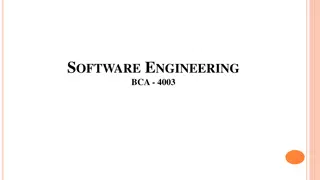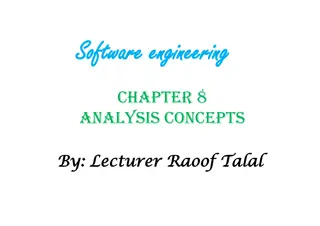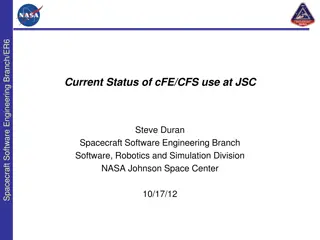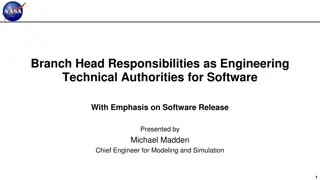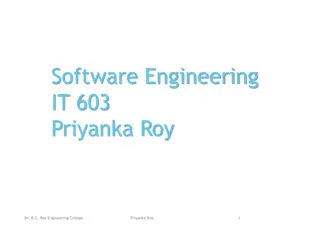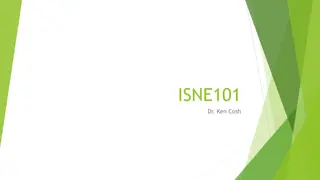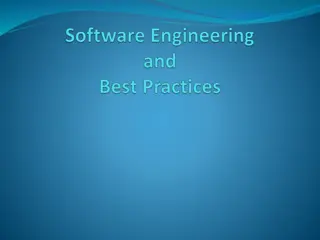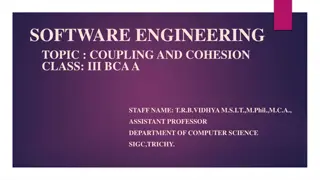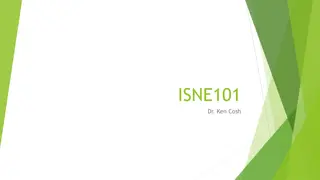
Reliable Programming in Software Engineering - Course Overview and Schedule
Explore the syllabus of a course on Reliable Programming in Software Engineering, covering topics such as software architecture, cloud-based software, RESTful services, and more. Dive into the world of reliable programming with this comprehensive curriculum taught by Associate Professor Min-Yuh Day.
Uploaded on | 0 Views
Download Presentation

Please find below an Image/Link to download the presentation.
The content on the website is provided AS IS for your information and personal use only. It may not be sold, licensed, or shared on other websites without obtaining consent from the author. If you encounter any issues during the download, it is possible that the publisher has removed the file from their server.
You are allowed to download the files provided on this website for personal or commercial use, subject to the condition that they are used lawfully. All files are the property of their respective owners.
The content on the website is provided AS IS for your information and personal use only. It may not be sold, licensed, or shared on other websites without obtaining consent from the author.
E N D
Presentation Transcript
(Software Engineering) (Reliable Programming) 1091SE10 MBA, IM, NTPU (M5118) (Fall 2020) Tue 2, 3, 4 (9:10-12:00) (B8F40) Min-Yuh Day Associate Professor Institute of Information Management, National Taipei University https://web.ntpu.edu.tw/~myday 2020-12-15 1
(Syllabus) (Week) (Date) (Subject/Topics) 1 2020/09/15 (Introduction to Software Engineering) 2 2020/09/22 (Software Products and Project Management: Software product management and prototyping) 3 2020/09/29 Scrum (Agile Software Engineering: Agile methods, Scrum, and Extreme Programming) 4 2020/10/06 (Features, Scenarios, and Stories) 5 2020/10/13 (Software Architecture: Architectural design, System decomposition, and Distribution architecture) 6 2020/10/20 I (Case Study on Software Engineering I) 2
(Syllabus) (Week) (Date) (Subject/Topics) 7 2020/10/27 (Cloud-Based Software: Virtualization and containers, Everything as a service, Software as a service) 8 2020/11/03 (Cloud Computing and Cloud Software Architecture) 9 2020/11/10 (Midterm Project Report) 10 2020/11/17 RESTful (Microservices Architecture: RESTful services, Service deployment) 11 2020/11/24 (Industry Practices of Software Engineering) 12 2020/12/01 (Security and Privacy) 3
(Syllabus) (Week) (Date) (Subject/Topics) 13 2020/12/08 II (Case Study on Software Engineering II) 14 2020/12/15 (Reliable Programming) 15 2020/12/22 (Testing: Functional testing, Test automation, Test-driven development, and Code reviews) 16 2020/12/29 DevOps DevOps (DevOps and Code Management: Code management and DevOps automation) 17 2021/01/05 I (Final Project Report I) 18 2021/01/12 II (Final Project Report I) 4
Software Engineering and Project Management Design Test Deliver Build Analyze System and Software design Integration and system testing Operation and maintenance Implementation and unit testing Requirements definition Project Management 5
Product management concerns Business needs Product manager Technology constraints Customer experience 6 Source: Ian Sommerville (2019), Engineering Software Products: An Introduction to Modern Software Engineering, Pearson.
Technical interactions of product managers Product vision management Product backlog management User stories and scenarios Product manager Acceptance testing Customer testing User interface design 7 Source: Ian Sommerville (2019), Engineering Software Products: An Introduction to Modern Software Engineering, Pearson.
Software Development Life Cycle (SDLC) The waterfall model Requirements definition System and Software design Implementation and unit testing Integration and system testing Operation and maintenance 8 Source: Ian Sommerville (2015), Software Engineering, 10th Edition, Pearson.
Plan-based and Agile development Plan-based development Requirements engineering Requirements specification Design and implementation Requirements change requests Agile development Requirements engineering Design and implementation 9 Source: Ian Sommerville (2015), Software Engineering, 10th Edition, Pearson.
The Continuum of Life Cycles High Incremental Agile Frequency of Delivery Predictive Iterative Low Low High Degree of Change 10 Source: Project Management Institute (2017), Agile Practice Guide, Project Management Institute
Predictive Life Cycle Analyze Design Build Test Deliver 11 Source: Project Management Institute (2017), Agile Practice Guide, Project Management Institute
Iterative Life Cycle Refine Prototype Analyze Design Build Test Analyze Deliver 12 Source: Project Management Institute (2017), Agile Practice Guide, Project Management Institute
A Life Cycle of Varying-Sized Increments Analyze Design Build Test Deliver Analyze Design Build Test Deliver Analyze Design Build Test Deliver 13 Source: Project Management Institute (2017), Agile Practice Guide, Project Management Institute
Iteration-Based and Flow-Based Agile Life Cycles Iteration-Based Agile Requirements Analysis Design Build Test Requirements Analysis Design Build Test Requirements Analysis Design Build Test Requirements Analysis Design Build Test Requirements Analysis Design Build Test Requirements Analysis Design Build Test Repeat as needed Flow-Based Agile Requirements Analysis Design Build Test the number of features in the WIP limit Requirements Analysis Design Build Test the number of features in the WIP limit Requirements Analysis Design Build Test the number of features in the WIP limit Requirements Analysis Design Build Test the number of features in the WIP limit Requirements Analysis Design Build Test the number of features in the WIP limit Repeat as needed 14 Source: Project Management Institute (2017), Agile Practice Guide, Project Management Institute
From personas to features 1 Personas A way of representing users inspire Natural language descriptions of a user interacting with a software product are-developed-into Scenarios 2 3 Natural language descriptions of something that is needed or wanted by users inspire Stories 4 Features define Fragments of product functionality 15 Source: Ian Sommerville (2019), Engineering Software Products: An Introduction to Modern Software Engineering, Pearson.
Multi-tier client-server architecture Client 1 Client 2 Web Server Application Server Database Server Client 3 Client 16 Source: Ian Sommerville (2019), Engineering Software Products: An Introduction to Modern Software Engineering, Pearson.
Service-oriented Architecture Client 1 S1 S2 Client 2 S3 Web Server Service gateway S4 Client 3 S5 S6 Client Services 17 Source: Ian Sommerville (2019), Engineering Software Products: An Introduction to Modern Software Engineering, Pearson.
VM Container Virtual web server Virtual mail server User 1 Container 1 User 2 Container 2 Server software Application software Application software Server software Guest OS Server software Server software Guest OS Hypervisor Container manager Host OS Host OS Server Hardware Server Hardware 18 Source: Ian Sommerville (2019), Engineering Software Products: An Introduction to Modern Software Engineering, Pearson.
Everything as a service Logistics management Software as a service (SaaS) Photo editing Database Software development Cloud Platform as a service (PaaS) management Monitoring Storage Network Infrastructure as a service (IaaS) Computing Virtualization Cloud data center 19 Source: Ian Sommerville (2019), Engineering Software Products: An Introduction to Modern Software Engineering, Pearson.
Software as a service Software customers Software provider Software services Cloud provider Cloud Infrastructure 20 Source: Ian Sommerville (2019), Engineering Software Products: An Introduction to Modern Software Engineering, Pearson.
Microservices architecture key design questions What are the microservices that make up the system? How should microservices communicate with each other? How should data be distributed and shared? Microservices architecture design How should the microservices in the system be coordinated? How should service failure be detected, reported and managed? 21 Source: Ian Sommerville (2019), Engineering Software Products: An Introduction to Modern Software Engineering, Pearson.
Types of security threat An attacker attempts to deny access to the system for legitimate users An attacker attempts to damage the system or its data Integrity threats Availability threats SOFTWARE PRODUCT PROGRAM Distributed denial of service (DDoS) attack Virus DATA Ransomware Data theft Confidentiality threats An attacker tries to gain access to private information held by the system 22 Source: Ian Sommerville (2019), Engineering Software Products: An Introduction to Modern Software Engineering, Pearson.
Reliable Programming 23
Outline Software quality Programming for reliability Design pattern Refactoring 24
Software quality Creating a successful software product does not simply mean providing useful features for users. You need to create a high-quality product that people want to use. Customers have to be confident that your product will not crash or lose information, and users have to be able to learn to use the software quickly and without mistakes. 25 Source: Ian Sommerville (2019), Engineering Software Products: An Introduction to Modern Software Engineering, Pearson.
Software product quality attributes 1 2 Reliability Availability 7 3 Software product quality attributes Security Resilience 6 4 5 Usability Maintainability Responsiveness 26 Source: Ian Sommerville (2019), Engineering Software Products: An Introduction to Modern Software Engineering, Pearson.
Programming for reliability There are three simple techniques for reliability improvement that can be applied in any software company. 1. Fault avoidance: You should program in such a way that you avoid introducing faults into your program. 2. Input validation: You should define the expected format for user inputs and validate that all inputs conform to that format. 3. Failure management: You should implement your software so that program failures have minimal impact on product users. 27 Source: Ian Sommerville (2019), Engineering Software Products: An Introduction to Modern Software Engineering, Pearson.
Underlying causes of program errors Programmers make mistakes because they don t properly understand the problem or the application domain Programmers make mistakes because they use unsuitable technology or they don t properly understand the technologies used Problem Technology Programming language, libraries, database, IDE, etc. Program Programmers make mistakes because they make simple slips or they do not completely understand how multiple program components work together the program s state. 28 Source: Ian Sommerville (2019), Engineering Software Products: An Introduction to Modern Software Engineering, Pearson.
Software complexity The shaded node interacts, in some ways, with the linked nodes shown by the dotted line 29 Source: Ian Sommerville (2019), Engineering Software Products: An Introduction to Modern Software Engineering, Pearson.
Program complexity Complexity is related to the number of relationships between elements in a program and the type and nature of these relationships The number of relationships between entities is called the coupling. The higher the coupling, the more complex the system. The shaded node has a relatively high coupling because it has relationships with six other nodes. 30 Source: Ian Sommerville (2019), Engineering Software Products: An Introduction to Modern Software Engineering, Pearson.
Software complexity A static relationship is one that is stable and does not depend on program execution. Whether or not one component is part of another component is a static relationship. Dynamic relationships, which change over time, are more complex than static relationships. An example of a dynamic relationship is the calls relationship between functions. 31 Source: Ian Sommerville (2019), Engineering Software Products: An Introduction to Modern Software Engineering, Pearson.
Types of complexity Reading complexity This reflects how hard it is to read and understand the program. This reflects the number and types of relationship between the structures (classes, objects, methods or functions) in your program. Structural complexity This reflects the representations of data used and relationships between the data elements in your program. Data complexity Decision complexity This reflects the complexity of the decisions in your program 32 Source: Ian Sommerville (2019), Engineering Software Products: An Introduction to Modern Software Engineering, Pearson.
Complexity reduction guidelines Structural complexity Functions should do one thing and one thing only Functions should never have side-effects Every class should have a single responsibility Minimize the depth of inheritance hierarchies Avoid multiple inheritance Avoid threads (parallelism) unless absolutely necessary 33 Source: Ian Sommerville (2019), Engineering Software Products: An Introduction to Modern Software Engineering, Pearson.
Complexity reduction guidelines Data complexity Define interfaces for all abstractions Define abstract data types Avoid using floating-point numbers Never use data aliases 34 Source: Ian Sommerville (2019), Engineering Software Products: An Introduction to Modern Software Engineering, Pearson.
Complexity reduction guidelines Conditional complexity Avoid deeply nested conditional statements Avoid complex conditional expressions 35 Source: Ian Sommerville (2019), Engineering Software Products: An Introduction to Modern Software Engineering, Pearson.
Ensure that every class has a single responsibility You should design classes so that there is only a single reason to change a class. If you adopt this approach, your classes will be smaller and more cohesive. They will therefore be less complex and easier to understand and change. The single responsibility principle Gather together the things that change for the same reasons. Separate those things that change for different reasons Source: Ian Sommerville (2019), Engineering Software Products: An Introduction to Modern Software Engineering, Pearson. 36
The DeviceInventory class DeviceInventory DeviceInventory laptops tablets phones device_assignment addDevice removeDevice assignDevice unassignDevice getDeviceAssignment printInventory laptops tablets phones device_assignment addDevice removeDevice assignDevice unassignDevice getDeviceAssignment (b) (a) 37 Source: Ian Sommerville (2019), Engineering Software Products: An Introduction to Modern Software Engineering, Pearson.
Adding a printInventory method One way of making this change is to add a printInventory method This change breaks the single responsibility principle as it then adds an additional reason to change the class. Instead of adding a printInventory method to DeviceInventory, it is better to add a new class to represent the printed report. 38 Source: Ian Sommerville (2019), Engineering Software Products: An Introduction to Modern Software Engineering, Pearson.
The DeviceInventory and InventoryReport classes DeviceInventory InventoryReport laptops tablets phones device_assignment addDevice removeDevice assignDevice unassignDevice getDeviceAssignment report_data report_format updateData updateFormat print 39 Source: Ian Sommerville (2019), Engineering Software Products: An Introduction to Modern Software Engineering, Pearson.
Avoid deeply nested conditional statements Deeply nested conditional (if) statements are used when you need to identify which of a possible set of choices is to be made. For example, the function agecheck is a short Python function that is used to calculate an age multiplier for insurance premiums. The insurance company s data suggests that the age and experience of drivers affects the chances of them having an accident, so premiums are adjusted to take this into account. It is good practice to name constants rather than using absolute numbers, so Program names all constants that are used. 40 Source: Ian Sommerville (2019), Engineering Software Products: An Introduction to Modern Software Engineering, Pearson.
Deeply nested if-then-else statements YOUNG_DRIVER_AGE_LIMIT = 25 OLDER_DRIVER_AGE = 70 ELDERLY_DRIVER_AGE = 80 YOUNG_DRIVER_PREMIUM_MULTIPLIER = 2 OLDER_DRIVER_PREMIUM_MULTIPLIER = 1.5 ELDERLY_DRIVER_PREMIUM_MULTIPLIER = 2 YOUNG_DRIVER_EXPERIENCE_MULTIPLIER = 2 NO_MULTIPLIER = 1 YOUNG_DRIVER_EXPERIENCE = 2 OLDER_DRIVER_EXPERIENCE = 5 def agecheck(age, experience): # Assigns a premium multiplier depending on the age and experience of the driver multiplier = NO_MULTIPLIER if age <= YOUNG_DRIVER_AGE_LIMIT: if experience <= YOUNG_DRIVER_EXPERIENCE: multiplier = YOUNG_DRIVER_PREMIUM_MULTIPLIER * YOUNG_DRIVER_EXPERIENCE_MULTIPLIER else: multiplier = YOUNG_DRIVER_PREMIUM_MULTIPLIER else: if age > OLDER_DRIVER_AGE and age <= ELDERLY_DRIVER_AGE: if experience <= OLDER_DRIVER_EXPERIENCE: multiplier = OLDER_DRIVER_PREMIUM_MULTIPLIER else: multiplier = NO_MULTIPLIER else: if age > ELDERLY_DRIVER_AGE: multiplier = ELDERLY_DRIVER_PREMIUM_MULTIPLIER return multiplier 41 Source: Ian Sommerville (2019), Engineering Software Products: An Introduction to Modern Software Engineering, Pearson.
Using guards to make a selection def agecheck_with_guards(age, experience): if age <= YOUNG_DRIVER_AGE_LIMIT and experience <= YOUNG_DRIVER_EXPERIENCE: return YOUNG_DRIVER_PREMIUM_MULTIPLIER * YOUNG_DRIVER_EXPERIENCE_MULTIPLIER if age <= YOUNG_DRIVER_AGE_LIMIT: return YOUNG_DRIVER_PREMIUM_MULTIPLIER if (age > OLDER_DRIVER_AGE and age <= ELDERLY_DRIVER_AGE) and experience <= OLDER_DRIVER_EXPERIENCE: return OLDER_DRIVER_PREMIUM_MULTIPLIER if age > ELDERLY_DRIVER_AGE: return ELDERLY_DRIVER_PREMIUM_MULTIPLIER return NO_MULTIPLIER 42 Source: Ian Sommerville (2019), Engineering Software Products: An Introduction to Modern Software Engineering, Pearson.
Avoid deep inheritance hierarchies Inheritance allows the attributes and methods of a class, such as RoadVehicle, can be inherited by sub-classes, such as Truck, Car and MotorBike. Inheritance appears to be an effective and efficient way of reusing code and of making changes that affect all subclasses. However, inheritance increases the structural complexity of code as it increases the coupling of subclasses. The problem with deep inheritance is that if you want to make changes to a class, you have to look at all of its superclasses to see where it is best to make the change. You also have to look at all of the related subclasses to check that the change does not have unwanted consequences. It s easy to make mistakes when you are doing this analysis and introduce faults into your program. 43 Source: Ian Sommerville (2019), Engineering Software Products: An Introduction to Modern Software Engineering, Pearson.
Part of the inheritance hierarchy for hospital staff Hospital staff Technicians Paramedics Clinical staff Scientist Admin staff Ancillary staff Doctor Nurse Physiotherapist Nurse Manager Midwife Ward nurse 44 Source: Ian Sommerville (2019), Engineering Software Products: An Introduction to Modern Software Engineering, Pearson.
Design pattern definition Definition A general reusable solution to a commonly-occurring problem within a given context in software design. 45 Source: Ian Sommerville (2019), Engineering Software Products: An Introduction to Modern Software Engineering, Pearson.
Design pattern Design patterns are object-oriented and describe solutions in terms of objects and classes. They are not off-the-shelf solutions that can be directly expressed as code in an object-oriented language. They describe the structure of a problem solution but have to be adapted to suit your application and the programming language that you are using. 46 Source: Ian Sommerville (2019), Engineering Software Products: An Introduction to Modern Software Engineering, Pearson.
Programming principles Separation of concerns This means that each abstraction in the program (class, method, etc.) should address a separate concern and that all aspects of that concern should be covered there. Separate the what from the how If a program component provides a particular service, you should make available only the information that is required to use that service (the what ). The implementation of the service ( the how ) should be of no interest to service users. 47 Source: Ian Sommerville (2019), Engineering Software Products: An Introduction to Modern Software Engineering, Pearson.
Common types of design patterns Creational patterns These are concerned with class and object creation. They define ways of instantiating and initializing objects and classes that are more abstract than the basic class and object creation mechanisms defined in a programming language. Structural patterns These are concerned with class and object composition. Structural design patterns are a description of how classes and objects may be combined to create larger structures. Behavioural patterns These are concerned with class and object communication. They show how objects interact by exchanging messages, the activities in a process and how these are distributed amongst the participating objects. 48 Source: Ian Sommerville (2019), Engineering Software Products: An Introduction to Modern Software Engineering, Pearson.
Pattern description Design patterns are usually documented in the stylized way. This includes: a meaningful name for the pattern and a brief description of what it does; a description of the problem it solves; a description of the solution and its implementation; the consequences and trade-offs of using the pattern and other issues that you should consider. 49 Source: Ian Sommerville (2019), Engineering Software Products: An Introduction to Modern Software Engineering, Pearson.
Refactoring Refactoring means changing a program to reduce its complexity without changing the external behaviour of that program. Refactoring makes a program more readable (so reducing the reading complexity ) and more understandable. It also makes it easier to change, which means that you reduce the chances of making mistakes when you introduce new features. 50 Source: Ian Sommerville (2019), Engineering Software Products: An Introduction to Modern Software Engineering, Pearson.

